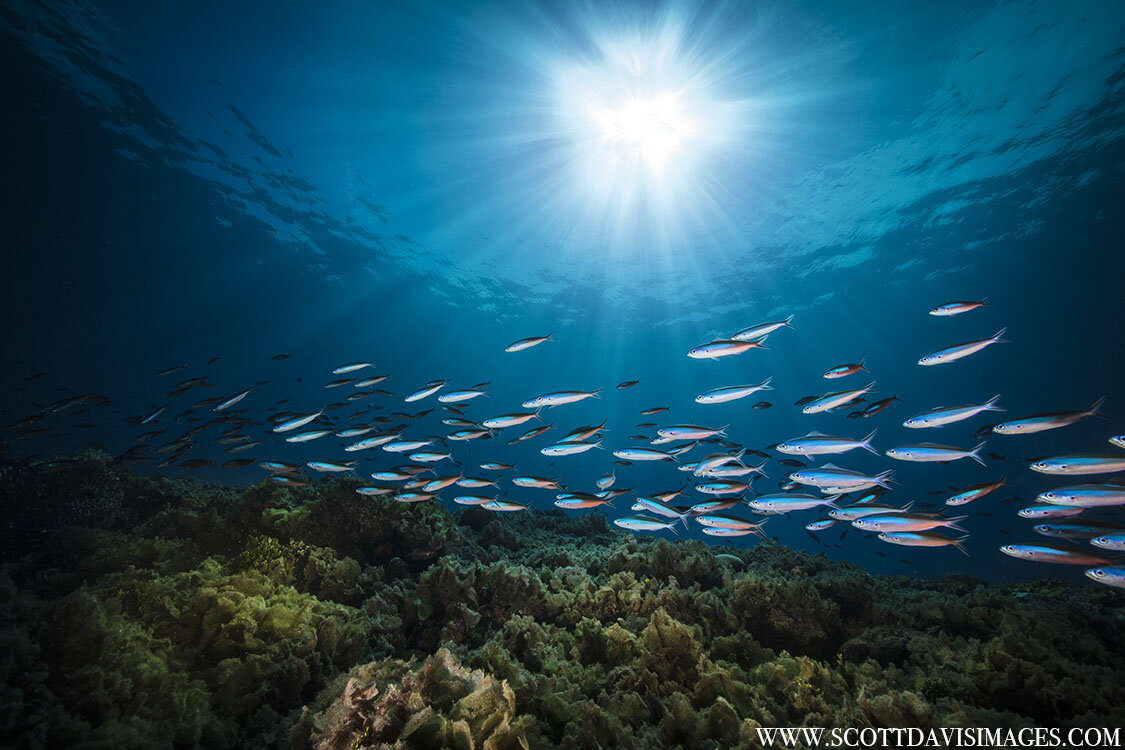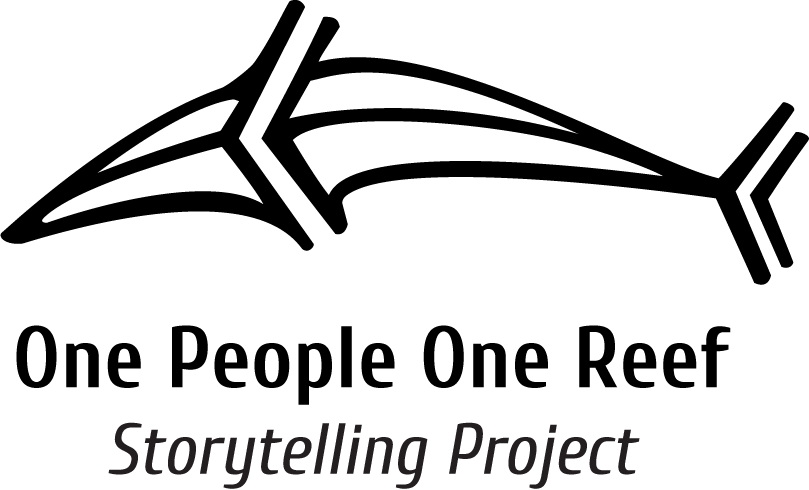
Titi Mata Mayomayo!
Stories and science of coral reef stewardship
This project was funded by grants from the National Geographic Society, the National Science Foundation, the National Oceanic and Atmospheric Administration, and the Kenneth S Norris Center for Natural History at the University of California Santa Cruz. National Geographic Grant #NGS-149E-18 | NOAA Grant #NA15NMF4270336 | National Science Foundation Grant #OCE 1546374
This work has resulted in a collection of seven Ulithian stories with English translations. A new story was written that weaves together elements found within the seven Ulithian stories with contemporary lessons about the value of traditional management rules and coral reef science. These stories are presented in audio (original live recordings and English translations) and a written booklet. Both the audio and written components are included on this website.
One People One Reef’s Storytelling Project aims to link the science and traditions of coral reef stewardship on the outer islands of Ulithi Atoll through the revitalization of STORYTELLING.
One People One Reef is a collaboration between Indigenous and western teams focusing on revitalizing marine stewardship in the Micronesian Outer Islands - the low lying coral islands and atolls neighboring the main islands. Our collective goal is to combine traditional knowledge and approaches with western science to identify and address ecosystem, resource and cultural challenges. The complex linkages between people and the ecosystems they steward are central to the protection of both Ulithi Atoll and the other Outer Islands of Yap have been our regional focus.
This Storytelling Project came from the recognition by outer islanders, particularly on Ulithi Atoll, that the loss of the traditions of storytelling were linked to a loss of knowledge and social frameworks that were integral to environmental stewardship, social cohesion, interdependence and relationship foundations. It has resulted in a selection of seven of the many foundational myths of Ulithian culture, as told by elders from each of the four inhabited islands of Ulithi Atoll in June 2018, and a new story that weaves together elements found within the seven Ulithian stories with contemporary lessons about the value of traditional management rules and coral reef science.
“It is imperative to keep learning, and what we are learning about our reefs, fish, and sea animals is important. I never imagined that we would face a time when the fish and seafood populations would diminish. Now it’s becoming clear to you. You know yourself that we are not catching enough fish, and so this is a story of understanding and compromise.”
ChiEf IsAac Lengal | Asor Island, 2018

Purpose
Micronesian Outer Island communities are experiencing rapid ecological and cultural change, and loss of traditional knowledge and practices. The Storytelling Project aims to support the restoration of traditional ecological knowledge specific to reef management, identifying links with science that connect traditional and western approaches. We partner with local people of all ages and roles to record, preserve, and share their stories in order to enhance local knowledge and strengthen engagement with reef management and conservation. The youth are integral to the success of this project, and the future of their communities. They are growing up less connected to their own culture and traditions. By addressing the loss of this knowledge this Project strengthens the communities and their time-honored traditional stewardship.
Capacity Building
The One People One Reef Storytelling Project builds capacity in outer island communities to manage and understand their reef systems in the context of a changing seascape. By collecting authentic stories and traditions and mixing them with their scientific story (when that correlation can be made), One People One Reef’s Storytelling Project is bridging modern scientific evidence with the efficacy of traditional stewardship to share and give back to the communities. Besides ecological change, communities are experiencing cultural change and loss of intellectual resources. This project helps restore knowledge specific to reef management, and combines it with contemporary scientific knowledge to support traditional approaches and empower the community.
Outer island schools are introducing cultural classes in recognition of the loss of important cultural systems, and this Project dovetails with that effort, providing resources for educators and students. This work reaches Micronesians now living outside of Micronesia, connecting them to their communities and encouraging them to bring intellectual resources ‘home’. Finally, it raises awareness in others of the importance of traditional management and the value of stories to reinforce conservation, compliance, and societal values.
“Listening is a fundamental skill, and you will benefit by learning about how we survive on these islands.” Maggie Tadog, Federai Island, 2018.
“Today we have entered an era in which our young children have started to leave home for Western schooling. More and more children are missing out on the traditional ways of learning from their parents. I believe this lack of quality time spent with parents has led to our generation’s lack of traditional knowledge and understanding.”
Maggie Tadog | Federai Island, 2018.

So, where exactly are these stories from?
The Federated States of Micronesia (FSM) is an island nation of four states (Yap, Chuuk, Pohnpei, Kosrae) in the Western Pacific. Yap state is known to be the most ‘traditional’ of the four states.
Yap State consists of 138 islands and atolls, 22 of which are populated, extending approximately 800 km (500 mi) eastward into the tropical western Pacific Ocean. Although the Yap outer islands encompass over 259,000 square kilometers of ocean, the state consists of only 117 square kilometers of land, much of which barely rises above sea level (the main island of Yap is a ‘high’ island). The autonomous governance, combined with the isolation of these islands, and the small human populations they support have led to a resource governance system that remains largely traditional, notwithstanding the influence of some more modern technologies such as motor boats, freezers and fishing gear.
Although Yap State is a collection of islands, ‘Outer Islanders’ (people from islands other than the largest main islands of Yap proper) often have a strong sense of cultural identity, and in many cases they differ significantly from communities on the main islands, including the language and leadership structure. Ulithi is the largest Atoll in the Yap Outer Islands, by some records the 4th largest atoll in the world. Ulithi Atoll is approximately 161 kilometers east of the main island of Yap. Where in the world is Ulithi Atoll?
Figure from Pacific Worlds Yap-Ulithi Website: "Location of Ulithi" Pacific Worlds, 2003: http://www.pacificworlds.com/yap/home/location.cfm
Ulithi Atoll is located in Yap State, Federated States of Micronesia. Figure from: CIA World Factbook.
Map of Ulithi Atoll. Figure from Pacific Worlds Yap-Ulithi Website: "Orientation" Pacific Worlds, 2003: http://www.pacificworlds.com/yap/home/oriented.cfm
“They’ve protected and managed their reefs well for thousands of years.”
Nicole Crane | Marine Biologist

Ready to Help?
—
Support this project




